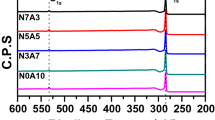Abstract
In the present study, carbon molded bodies were prepared by using graphite/coke fillers and petroleum-based binder pitch with various softening points, and the thermal properties of the prepared carbon molded bodies were investigated. The ratio of a binder affects the molded body preparation: no molded body was prepared at a low binder pitch content, and swelling occurred during the thermal treatment at a high binder pitch content. The binder pitch thermal treatment yield was the highest at 41 wt% at the softening point of 150 °C and the lowest at 23 wt% at the softening point of 78 °C. A significant mass reduction was found in the range of 150 to 300 °C in the petroleum-based binder pitch, and in the range of 300 to 475 °C in the coal-based binder pitch. The molecular weight of the binder pitch was analyzed through the matrix-assisted laser desorption/ionization time-of-flight (MALDI-TOF) method. The molecular weight ratio within the interval showing the highest binder pitch molecular weight (178 to 712 m/z) was the highest at 66.4% in the coal-based binder pitch (softening point 115 °C) and the lowest at 46.0% in the petroleum-based binder pitch (softening point 116 °C). When the petroleum-based binder pitch was applied, as the softening point was increased, the voids decreased and thus the thermal conductivity increased. The highest thermal conductivity was 99.5 W/mK for the carbon molded bodies prepared using the coal-based binder pitch and 102.8 W/mK for those prepared by using the petroleum-based binder pitch. The results showed that the thermal properties were similar between the coal-based binder pitch (softening point 115 °C) and the petroleum-based binder pitch (softening point 150 °C).






Similar content being viewed by others
References
Brisson PY, Darmstadt H, Fafard M, Adnot A, Servant G, Soucy G (2006) X-ray photoelectron spectroscopy study of sodium reactions in carbon cathode blocks of aluminium oxide reduction cells. Carbon 44:8. https://doi.org/10.1016/j.carbon.2005.11.030
Chin-Tu L, Bryant MD (1994) Thermoelastic evolution of contact area and mound temperatures in carbon graphite electrical brushes. Wear 174:1–2. https://doi.org/10.1016/0043-1648(94)90095-7
Ding T, Chen G, Bu J, Zhang W (2011) Effect of temperature and arc discharge on friction and wear behaviours of carbon strip/copper contact wire in pantograph–catenary systems. Wear 271:9–10. https://doi.org/10.1016/j.wear.2010.12.031
Lin JW, Chang HC (2011) Measurement of friction surface and wear rate between a carbon graphite brush and a copper ring. Tribol Trans 54:6. https://doi.org/10.1080/10402004.2011.613555
Zj Liu, Jl Zhang, Hb Zuo, Tj Yang (2012) Recent progress on long service life design of Chinese blast furnace hearth. ISIJ Int 52:10. https://doi.org/10.2355/isijinternational.52.1713
Xiaowei L, Jean-Charles R, Suyuan Y (2004) Effect of temperature on graphite oxidation behavior. Nucl Eng Des. https://doi.org/10.1016/j.nucengdes.2003.11.004
Sorlie M, Oye H (1992) Cathodes in aluminium electrolysis. Aluminium-Verlag GmbH, Dusseldorf, p 350
Yurkov A, Khramenko S, Borisov V (2008) Effect of the structure and properties of hearth carbon blocks on premature shutdown of electrolytic baths. Refract Ind Ceram 49:2
Yuan G, Li X, Dong Z, Westwood A, Cui Z, Cong Y, Kang F (2012) Graphite blocks with preferred orientation and high thermal conductivity. Carbon 50:1. https://doi.org/10.1016/j.carbon.2011.08.017
Zhong B, Zhao G, Huang X, Liu J, Chai Z, Tang X, Wu Y (2014) Binding natural graphite with mesophase pitch: a promising route to future carbon blocks. Mater Sci Eng, A 610:29. https://doi.org/10.1016/j.msea.2014.05.038
Fitzer E (1987) The future of carbon-carbon composites. Carbon 25(2):163–190. https://doi.org/10.1016/0008-6223(87)90116-3
Pierson HO (2012) Handbook of carbon, graphite, diamonds and fullerenes: processing, properties and applications. William Andrew, Norwich. https://www.elsevier.com/books/handbook-of-carbon-graphite-diamonds-and-fullerenes/pierson/978-0-8155-1339-1
Inagaki M, Kang F (2014) Materials science and engineering of carbon: fundamentals. Butterworth-Heinemann, Oxford. https://doi.org/10.1016/B978-0-12-800858-4.00002-4
Choi JE, Ko S, Jeon YP (2019) Preparation of petroleum impregnating pitches from pyrolysis fuel oil using two-step heat treatments. Carbon Lett 29:1. https://doi.org/10.1007/s42823-019-00041-z
Sakai M (1979) Dependence of viscoelastic properties of a carbon paste on grain size of coke. Carbon 17:2. https://doi.org/10.1016/0008-6223(79)90022-8
Kim JG, Kim JH, Bai BC, Choi YJ, Im JS, Bae TS, Lee YS (2018) Influence of kneading ratio on the binding interaction of coke aggregates on manufacturing a carbon block. Carbon Lett 28:1. https://doi.org/10.5714/cl.2018.28.024
Golounin A, Sokolenko V, Khramenko S, Marakushina E (2009) Catalytic transformation of the alkylation products of naphthalene. Coke Chemy 52:3. https://doi.org/10.3103/S1068364X09030077
Lee SM, Kim KH, Lee YS (2017) Preparation of carbon discs using petroleum-based binder pitch reformed with carbon black. Carbon Lett 23:1. https://doi.org/10.5714/cl.2017.23.084
Song Y, Zhai G, Li G, Shi J, Guo Q, Liu L (2004) Carbon/graphite seal materials prepared from mesocarbon microbeads. Carbon 42:8–9. https://doi.org/10.1016/j.carbon.2003.12.037
Kim JG, Kim JH, Song BJ, Jeon YP, Lee CW, Lee YS, Im JS (2016) Characterization of pitch derived from pyrolyzed fuel oil using TLC-FID and MALDI-TOF. Fuel 167:1. https://doi.org/10.1016/j.fuel.2015.11.050
Kim HG, Kim YS, Kwac LK, Kuk YS, Shin HK (2018) Characterization of Toluene- and Quinoline-Insoluble Extracted from Pyrolysis Fuel Oil-Derived Pitch for Manufacture of C/C Composites. Int J Precis Eng Manuf 19:7. https://doi.org/10.1007/s12541-018-0122-z
Acknowledgements
This work was supported by the Korea Institute of Energy Technology Evaluation and Planning (KETEP) grant funded by the Ministry of Trade, Industry & Energy (MOTIE) of the Republic of Korea (No. 10077710, Development of 600 W/mk grade exothermal material & component preparation by petroleum based pitch).
Author information
Authors and Affiliations
Corresponding authors
Additional information
Publisher's Note
Springer Nature remains neutral with regard to jurisdictional claims in published maps and institutional affiliations.
Electronic supplementary material
Below is the link to the electronic supplementary material.
Rights and permissions
About this article
Cite this article
Cho, J.H., Im, J.S., Kim, M.I. et al. Preparation of petroleum-based binder pitch for manufacturing thermally conductive carbon molded body and comparison with commercial coal-based binder pitch. Carbon Lett. 30, 373–379 (2020). https://doi.org/10.1007/s42823-019-00106-z
Received:
Revised:
Accepted:
Published:
Issue Date:
DOI: https://doi.org/10.1007/s42823-019-00106-z




